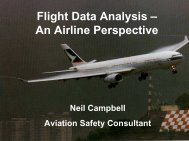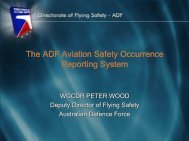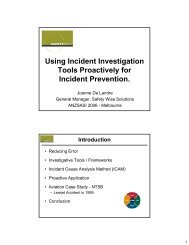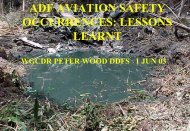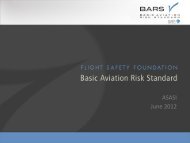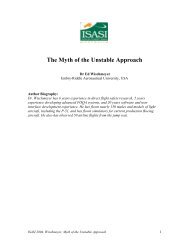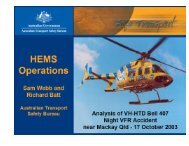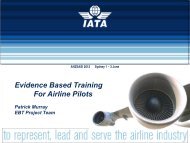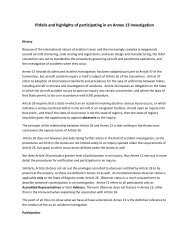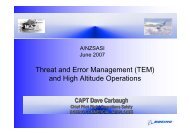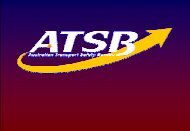communication in aviation safety: lessons learned and ... - ASASI
communication in aviation safety: lessons learned and ... - ASASI
communication in aviation safety: lessons learned and ... - ASASI
Create successful ePaper yourself
Turn your PDF publications into a flip-book with our unique Google optimized e-Paper software.
When the aircraft was stopped <strong>and</strong> the eng<strong>in</strong>es shut down, my next concern wasthe location of the mechanic <strong>and</strong> whether he was okay. He was.Although this mechanic speaks fairly good English, I was truly surprised at thelevel of <strong>communication</strong> breakdown that had just occurred. The mechanic told mehe thought I was tell<strong>in</strong>g him that I was releas<strong>in</strong>g the park<strong>in</strong>g brake.Once we started roll<strong>in</strong>g he did not tell us to stop, but <strong>in</strong>stead simply unplugged hisheadset <strong>and</strong> got out of the way.What <strong>lessons</strong> can be <strong>learned</strong> or re<strong>learned</strong> from all of this? First of all this is arem<strong>in</strong>der of someth<strong>in</strong>g we all know, that be<strong>in</strong>g towed is an operation whichrequires someone to be monitor<strong>in</strong>g the aircraft. Secondly, never assumeanyth<strong>in</strong>g. S<strong>in</strong>ce we never saw the tug pull away (it pulled away while we were <strong>in</strong>the books) <strong>and</strong> we were told to release the park<strong>in</strong>g brake, we thought we wereunder tow.Dur<strong>in</strong>g approach brief<strong>in</strong>gs, simulator tra<strong>in</strong><strong>in</strong>g, <strong>and</strong> l<strong>in</strong>e non-normal operationsflight, someone is always assigned the task of monitor<strong>in</strong>g the aircraft. Let thisserve as a rem<strong>in</strong>der to do the same dur<strong>in</strong>g tow operations.Thank goodness no one was hurt, no metal was bent, <strong>and</strong> no careers were put <strong>in</strong>jeopardy, but we sure came darn close (Callback, 2005, November, p. 1; emphasisadded).While be<strong>in</strong>g vectored on a downw<strong>in</strong>d leg to Runway 01L, Tower asked if we hadthe field <strong>in</strong> sight, which we did. At that time we were cleared for a visualapproach to Runway 01L <strong>and</strong> a left turn back to the field was <strong>in</strong>itiated to result <strong>in</strong>a f<strong>in</strong>al of approximately 6 miles. When approximately 60° from the runwayhead<strong>in</strong>g, Tower reported traffic (a B-757) jo<strong>in</strong><strong>in</strong>g a f<strong>in</strong>al for runway 01R. Whilelook<strong>in</strong>g for the traffic the First Officer, who was fly<strong>in</strong>g the aircraft, took his eyesoff the field <strong>and</strong> shallowed his bank... When I realized he was not just squar<strong>in</strong>goff his f<strong>in</strong>al but was go<strong>in</strong>g to overshoot the runway I told him he was go<strong>in</strong>g toovershoot <strong>and</strong> ordered a turn back to our runway. He seemed disoriented <strong>and</strong> wasslow <strong>in</strong> respond<strong>in</strong>g, result<strong>in</strong>g <strong>in</strong> a significant overshoot approach<strong>in</strong>g the approachcorridor for Runway 01R. A TCAS II-Resolution Advisory resulted with a"monitor vertical speed" comm<strong>and</strong> which was complied with. Tower questionedif we had the traffic <strong>in</strong> sight which we answered <strong>in</strong> the affirmative. We correctedback to the 01L centerl<strong>in</strong>e <strong>and</strong> l<strong>and</strong>ed with no further <strong>in</strong>cident.In talk<strong>in</strong>g to the First Officer after the l<strong>and</strong><strong>in</strong>g, he <strong>in</strong>dicated that he lost sight ofthe runway <strong>in</strong> the left turn. Also that he never actually saw the B-757. Although I<strong>in</strong>dicated that I saw the traffic <strong>and</strong> po<strong>in</strong>ted it out, the First Officer did not see it,but I assumed he did. I also assumed that he had the runway <strong>in</strong> sight, so I wasunaware that he had lost situational awareness.The lesson to me is to never assume another crew member is see<strong>in</strong>g the sameth<strong>in</strong>g I am <strong>and</strong> to work to communicate what I am see<strong>in</strong>g even when weather is7



